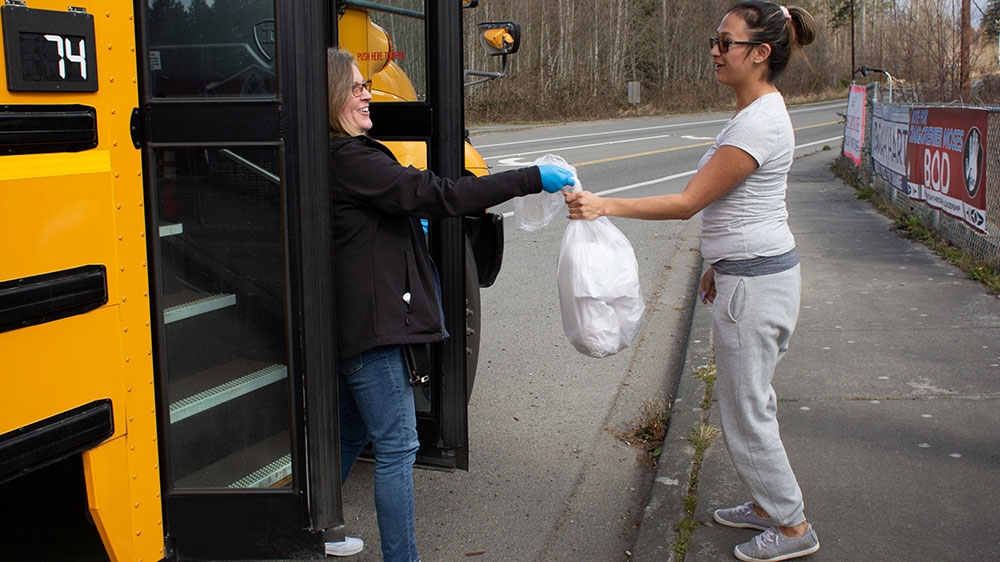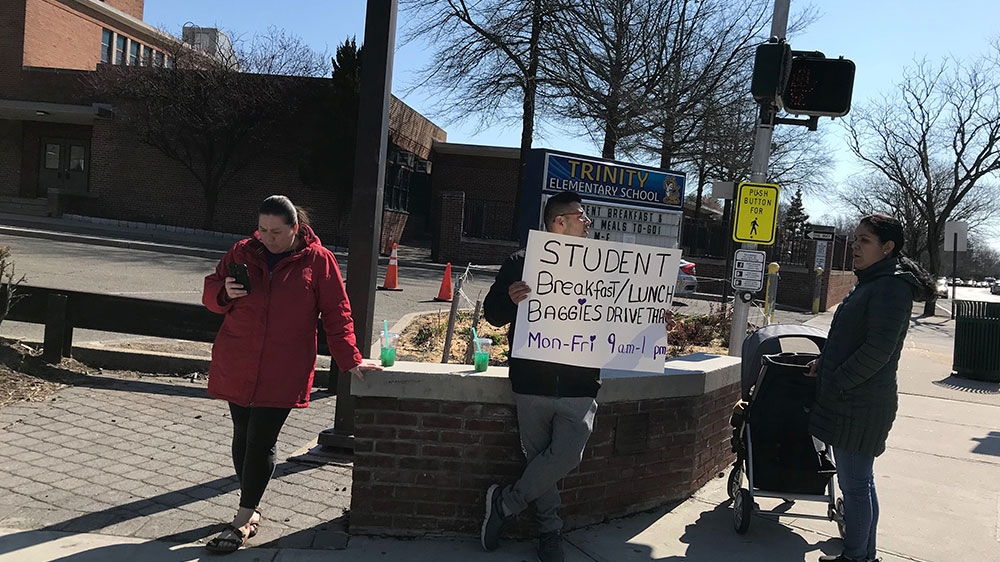Coronavirus: Homeless families lose key support as schools close
Health experts advise closing schools, but for unstably housed families, that brings difficult choices, increased risk.

Seattle, United States – In a typical year, homeless shelters experience the biggest surge in demand not during the cold winter months, but rather during the summer.
In the summer, schools close and parents lose the usual daily eight hours of childcare and meals. With the additional burden of sleeping on the streets, parents seek out shelter more often, research has shown.
Keep reading
list of 3 itemsCoronavirus: Why so many deaths in Italy?
Timeline: How the new coronavirus spread
“Now what we have nationally is summer is coming early,” says Gregg Colburn, a real estate professor at the University of Washington who has studied the summer surge in homeless shelters’ population.
Across the United States, schools have already shut their doors to prevent the spread of the COVID-19 virus that has so far infected more than half a million people and taken more than 25,000 lives worldwide. The US now has the most confirmed cases, with more than 92,000. Over 1,300 people have died in the country.
Health experts have advised closing schools to prevent the spread of the coronavirus, but for unstably housed families and their children, that means being left without a key institution that provides a number of services, including meals, therapy, and crucially, sheltered childcare.
Inequality compounded by pandemic
Homeless children in grade school in the US number 1.5 million, according to the most recent data from the National Center for Homeless Education, and the number of homeless children under age six could be almost as high.
During the summer holiday, parents can still work. To reduce the risk of the virus spreading, however, several states have virtually frozen non-essential jobs, multiplying the burdens on families with school-age children who were already struggling to stay afloat.
“[The closures] take a population that was already very vulnerable to these things and takes away a lot of the services that prop them up,” said Christine Ma, a pediatrician at Benioff Children’s Hospital in Oakland, California.
“In some instances, they lost their one constant connection, a school, and they’re really on their own now,” said Ma.

For those who are not restricted from working, many often face a difficult choice: going to work to make enough money to put food on the table and pay the rent or mortgage, or taking pay cuts and shorter shifts to stay home with their children.
Other workers have been let go altogether, leaving parents scrambling to pay rent. Some schools have sent booklets of work to continue childrens’ education, effectively turning parents into teachers. Finding someone to take care of kids brings households into contact, preventing social distancing measures recommended by the US Centers for Disease Control and Prevention (CDC).
The burden is felt even greater by families who already have no roofs over their heads. Some shelters have begun rejecting families, either due to a lack of space or because they don’t want to risk introducing the virus to already housed people. Parents, not wanting to see their children sleep on the street, find places to send their kids away from the anxiety and fear they experience.
“We already have a relatively unequal society, and that inequality will compound during this crisis,” said Colburn, who also leads the University of Washington’s Homelessness Research Initiative.
‘Whole new world’
Ma runs a volunteer medical group, Kerry’s Kids, that visits homeless children in shelters in San Francisco, California. Without the ability to ensure sterilisation and care for potential coronavirus victims, the team made the difficult decision to close.
“I have a lot of patients that I’m worried about,” Ma said.
Aid workers on the front line of homelessness in the US say they are in uncharted territory, but structures in place can be used to address the intensified crises.
“It’s a whole new world,” said Barbara Duffield, executive director of SchoolHouse Connection, a non-profit organisation working to overcome homelessness through education. For weeks, she has been fielding questions from school workers from around the country.
“There’s a lot of people trying to understand what consistency looks like when you don’t have eight hours in school a day,” Duffield said.
In addition to housing, the biggest need around the country is for mobile hot spots, she said. Some families have resorted to sitting outside closed libraries to access Wi-Fi to complete necessary case management paperwork involving anything from affordable housing to child development services to Alcoholics Anonymous meetings.
“If you have a portion of the population that was just hanging on, I think the school closure is another huge jolt to this, because the meals they provide, the childcare they provide,” said Colburn.

There is an increased need for food banks – and there are worries about the country’s food supplies.
According to Lark Kesterke, the director of Impact & Investments for United Way Snohomish County, supplies have decreased 50 percent in the county, which is near Seattle, Washington and near where the first US case of COVID-19 was confirmed. Most food banks receive extra food from grocery stores, but customers rushing to fill their home stocks out of panic have depleted stocks.
“Literally there is no food that grocery stores can surplus out because they have their own supply issues,” said Kesterke.
Most schools that have closed are continuing to provide meals on site for students. Others have turned school bus drivers into a meal delivery brigade. More difficult to place, though, are the childcare services and mental health services, which students often rely on.
“The impact I’m concerned about from a health standpoint is their developmental and mental health,” said Ma. “There’s a huge amount of anxiety and it trickles down from parents, too.”
Harder to fight continuing crises
Officials in the Seattle area have taken steps to reduce pressures on unstably housed families, such as banning rent-related evictions. Deficits in affordable housing needs are still prominent, but for some residents, they can be sure that they can stay for another month or two.
“The anxiety is high. Some have been laid off and they’re trying to search for housing and figure out how they are going to make rent,” said Monica Best-Wilson, a school psychologist who works with Housing Hope, a non-profit organisation that addresses poverty through housing, jobs and children.
“Now that there is the 30-day stay on evictions, they can take a breath and wait,” she said.

In her experience, though, that’s only one pressure among many when families need to care for children. Some parents have needed to become their children’s teachers, even as they juggle work while maintaining CDC guidelines for social distancing.
Colburn is worried the virus could spread “like wildfire” among unstably housed families. Nutrition and healthcare are often enduring problems.
“Anytime there’s increased stress, that strains the immune system,” said Ma.
The US already has a structure in place to address homeless children in education, based on the McKinney-Vento act first signed in 1987. It includes a wider definition of homelessness such that students in unstable housing will also receive the attention and benefits that support their schooling.
Duffield of SchoolHouse Connection has asked that funding for the programmes it mandates receive an additional $300m in emergency funds on top of the current $92.5m annually.
“This is going to uniquely harm low-ncome households, and that’s hopefully going to be reflected in the major fiscal efforts taken by the federal government,” said Colburn.
The Senate passed a stimulus bill this week, which includes direct payments to millions of Americans and opens up hundreds of millions of dollars in aid to states for jobless aid. The House of Representatives is expected to pass the bill later this week. It is unclear where many homeless individuals would qualify for receiving any direct payment benefits since the government is relying on the last two year’s tax returns.
Additionally, such a pandemic makes addressing crises that have affected many Americans for decades even more challenging.
“One of the real scary aspects of this from a housing standpoint is that we still have a huge deficit of affordable housing,” Colburn said.
“It takes a lot of capital to build affordable housing, but going forward, government budgets will be severely constrained,” Colburn added.
“We know what works in terms of housing policy and low-income households. The issue is not trying to figure out what works. The issue is identifying the political will and resources to expand those programmes.”